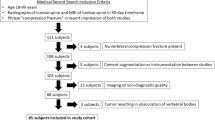Abstract
Introduction
The Thoracolumbar Injury Classification and Severity (TLICS) scale has been considered one of the best available grading systems for evaluating thoracolumbar fractures, especially due to the fact that, differently from previous classifications, it can be used as a practical algorithm to orient the clinical decision-making between conservative and surgical management.
Case report
The authors describe a case of a 54-year-old patient presenting with low-back pain after having struck her back on the handrail. The neurological exam was unremarkable. The CT-scan of the lumbar spine demonstrated a L1 comminuted burst fracture. The MRI demonstrated no evidence of posterior ligamentous complex injury. According to the TLICS classification (total score of 2) the patient was managed conservatively with a thoracolumbar brace. Although at the 1-month follow-up the X-rays demonstrated no major changes and the pain had clinically improved, the patient was lost to follow-up. After 12 months the patient presented back to the emergency department with complaints of increased back pain. The repeat CT-scan demonstrated a remarkable worsening of the vertebral body fracture, with a major kyphotic deformity. The patient was submitted to a staged anterior–posterior procedure consisting in posterior decompression of the T12–L2 levels, a T10–L4 pedicle screw fixation and, finally, a lateral transpsoas approach for L1 corpectomy and reconstruction with an expandable interbody cage and plate fixation. At the 6-months follow-up, the patient presented another episode of back pain and a new L4 endplate fracture was identified. After 2 months of failed conservative treatment, the patient was treated with percutaneous kyphoplasty. At the 12-months follow-up after the initial surgical procedure, the patient was pain free and with stable radiographs.
Conclusions
In this Grand Rounds presentation, the authors perform a comprehensive discussion about the historical developments in the classification systems for thoracolumbar fractures with special emphasis in the new TLICS system. Although such score presents several advantages in relation to other grading systems, patients with comminuted burst fractures deserve special attention, even if initially classified as non-operative according to the TLICS algorithm. In such cases, if a decision of conservative management is taken, a close follow-up is recommended due to the high likelihood of long-term kyphotic deformity.






Similar content being viewed by others
References
Böhler L (1929) The treatment of fractures (A translation of “Technik der Knochenbruchbehandlung im Frieden und im Kriege” by E. Vienna). Wilhelm Maudrich, Austria
Watson-Jones R (1938) The results of postural reduction of fractures of the spine. J Bone Joint Surg Am 20:567–586
Nicoll EA (1949) Fractures of the dorso-lumbar spine. J Bone Joint Surg Br 31(3):376–394
Sethi MK, Schoenfeld AJ, Bono CM, Harris MB (2009) The evolution of thoracolumbar injury classification systems. Spine J 9(9):780–788
Holdsworth FW (1963) Fractures, dislocations and fracture-dislocations of the spine. J Bone Joint Surg Br 45:6–20
Louis R (1985) Spinal stability as defined by the three-column spine concept. Anat Clin 7(1):33–42
Denis F (1983) The three column spine and its significance in the classification of acute thoracolumbar spinal injuries. Spine 8(8):817–831
Muller ME, Nazarian S, Koch P et al (1990) The Comprehensive Classification of Fractures of Long Bones. Springer, Berlin
Magerl F, Aebi M, Gertzbein SD, Harms J, Nazarian S (1994) A comprehensive classification of thoracic and lumbar injuries. Eur Spine J 3(4):184–201
Aebi M (2010) Classification of thoracolumbar fractures and dislocations. Eur Spine J 19(Suppl 1):S2–S7
Reinhold M, Audigé L, Schnake KJ, Bellabarba C, Dai LY, Oner FC (2013) AO spine injury classification system: a revision proposal for the thoracic and lumbar spine. Eur Spine J 22(10):2184–2201
Vaccaro AR, Lehman RA Jr, Hurlbert RJ, Anderson PA, Harris M, Hedlund R, Harrop J, Dvorak M, Wood K, Fehlings MG, Fisher C, Zeiller SC, Anderson DG, Bono CM, Stock GH, Brown AK, Kuklo T, Oner FC (2005) A new classification of thoracolumbar injuries: the importance of injury morphology, the integrity of the posterior ligamentous complex, and neurologic status. Spine 30(20):2325–2333
Patel AA, Dailey A, Brodke DS, Daubs M, Harrop J, Whang PG, Vaccaro AR (2009) Thoracolumbar spine trauma classification: the Thoracolumbar Injury Classification and Severity Score system and case examples. J Neurosurg Spine 10(3):201–206
Vaccaro AR, Oner C, Kepler CK, Dvorak M, Schnake K, Bellabarba C, Reinhold M, Aarabi B, Kandziora F, Chapman J, Shanmuganathan R, Fehlings M, Vialle L (2013) AOSpine thoracolumbar spine injury classification system: fracture description, neurological status and key modifiers. Spine (Phila Pa 1976) 38(23):2028–2037
McAfee PC, Yuan HA, Lasda NA (1982) The unstable burst fracture. Spine 7(4):365–373
McCormack T, Karaikovic E, Gaines RW (1994) The load sharing classification of spine fractures. Spine 19(15):1741–1744
Joaquim AF, Daubs MD, Lawrence BD, Brodke DS, Cendes F, Tedeschi H, Patel AA (2013) Retrospective evaluation of the validity of the thoracolumbar injury classification system in 458 consecutively treated patients. Spine J 13(12):1760–1765
Verheyden AP, Hölzl A, Ekkerlein H, Gercek E, Hauck S, Josten C, Kandziora F, Katscher S, Knop C, Lehmann W, Meffert R, Müller CW, Partenheimer A, Schinkel C, Schleicher P, Schnake KJ, Scholz M, Ulrich C (2011) Recommendations for the treatment of thoracolumbar and lumbar spine injuries. Unfallchirurg 114:9–16
Conflict of interest
The authors declare no conflict of interests. No financial or material support was received for the production of this manuscript.
Author information
Authors and Affiliations
Corresponding author
Rights and permissions
About this article
Cite this article
Mattei, T.A., Hanovnikian, J. & H. Dinh, D. Progressive kyphotic deformity in comminuted burst fractures treated non-operatively: the Achilles tendon of the Thoracolumbar Injury Classification and Severity Score (TLICS). Eur Spine J 23, 2255–2262 (2014). https://doi.org/10.1007/s00586-014-3312-0
Received:
Revised:
Accepted:
Published:
Issue Date:
DOI: https://doi.org/10.1007/s00586-014-3312-0





